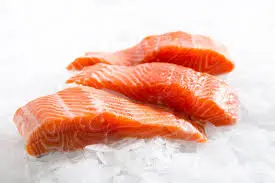Can a Dog Eat Salmon? Comprehensive Guide
For pet owners seeking healthy additions to their dog’s diet, salmon often appears as a beneficial option. Known for its high-quality protein and rich omega-3 content, salmon is frequently used in commercial dog foods and treats. However, to safely incorporate salmon into a dog’s diet, it’s essential to understand its nutritional benefits, potential risks, and the safest ways to serve it. This article will provide a detailed look at whether salmon is a safe choice for dogs and how to offer it in a way that maximizes its nutritional value while minimizing any risks.

Is Salmon Safe for Dogs?
Yes, salmon is safe for dogs when prepared and served properly. Not only is it rich in nutrients, but it also provides lean protein and essential fatty acids that can contribute to a dog’s overall health. However, feeding salmon to dogs requires caution; the fish should always be fully cooked and free from any additional seasoning, sauces, or spices. Raw salmon should be avoided, as it may contain parasites harmful to dogs.
Nutritional Benefits of Salmon for Dogs
Salmon offers numerous health benefits due to its impressive nutritional profile. Here’s a look at the key nutrients in salmon and how they can support a dog’s health:
- Omega-3 Fatty Acids: One of the primary reasons salmon is beneficial for dogs is its high omega-3 content. Omega-3 fatty acids support skin and coat health, reduce inflammation, and promote cardiovascular and joint health.
- High-Quality Protein: Salmon provides lean protein that supports muscle development, tissue repair, and immune function.
- Vitamins and Minerals: Salmon is rich in essential vitamins, including B12, D, and E, which support immune health, energy levels, and coat health. It also contains minerals like selenium and potassium, which aid in cellular health and maintain healthy blood pressure.
- Antioxidants: Salmon contains antioxidants that can help combat free radicals and reduce inflammation, supporting overall well-being.
Potential Risks of Feeding Salmon to Dogs
While salmon is nutritious, there are also some risks associated with feeding it to dogs. By understanding these risks, pet owners can better ensure their dog’s safety when offering salmon as a treat or dietary supplement.
- Salmon Poisoning Disease: Raw or undercooked salmon may contain a parasite called Neorickettsia helminthoeca, which can cause salmon poisoning disease in dogs. This condition is specific to canines and can be life-threatening if untreated. Symptoms include vomiting, diarrhea, fever, and lethargy.
- Bones: Salmon has small, thin bones that can pose a choking hazard or cause injury to a dog’s digestive tract. To reduce this risk, remove any visible bones or purchase deboned salmon for your dog.
- Mercury Content: Like all fish, salmon may contain trace amounts of mercury. While this is generally not an issue in moderate amounts, high exposure to mercury over time can be harmful. It’s best to vary your dog’s protein sources to avoid excessive mercury intake.
- Allergies: While uncommon, some dogs may be allergic to salmon or certain fish proteins. Monitor for any signs of allergies, such as itching, swelling, or digestive upset when introducing salmon for the first time.
How to Safely Prepare Salmon for Dogs
For dogs to enjoy salmon safely, it must be prepared in a way that eliminates any potential hazards. Here are steps to ensure salmon is cooked and served safely:
- Cook Thoroughly: Always cook salmon thoroughly to eliminate any risk of parasites or harmful bacteria. Baking, grilling, or steaming are safe methods. Avoid frying, as it introduces extra fat, which can be difficult for some dogs to digest.
- Remove Bones: Carefully check for bones before serving. Even small bones can pose a risk, so be diligent in removing all visible bones.
- Avoid Seasoning: Dogs should be served plain salmon, without salt, garlic, onions, or any spices that could upset their digestive system or lead to toxicity.
- Serve in Moderation: Salmon should be an occasional treat or supplement rather than a main protein source. Offering small portions reduces the risk of mercury accumulation and provides balanced variety in their diet.
How Much Salmon Can a Dog Eat?
While salmon can offer a nutritious boost, moderation is key. The portion size depends on your dog’s size, dietary needs, and overall health. Here are some general guidelines for feeding salmon to dogs:
- Small Dogs: About one ounce of cooked salmon per week is sufficient as a treat.
- Medium Dogs: Medium-sized dogs can enjoy about two ounces once a week.
- Large Dogs: Large breeds can consume up to three to four ounces once or twice a week.
These portion sizes are meant to complement a balanced diet. Too much salmon or any new food introduced in large amounts may upset a dog’s stomach.
Signs of Salmon Allergy or Intolerance in Dogs
Some dogs may be allergic to fish or specific types of protein found in salmon. While rare, an allergy or intolerance can cause symptoms that vary in severity. Signs to watch for include:
- Itching and Redness: Persistent itching, scratching, or inflamed skin can indicate an allergic reaction.
- Digestive Issues: Vomiting, gas, or diarrhea may be signs of an intolerance or sensitivity to salmon.
- Ear Infections: Repeated ear infections are sometimes linked to food allergies and could be a sign that a particular food doesn’t agree with your dog.
If your dog shows any of these symptoms after eating salmon, it’s best to consult a veterinarian. They may recommend an alternative protein source to avoid future reactions.
Benefits of Omega-3s in Salmon for Dogs
One of the most beneficial components of salmon is its omega-3 fatty acids, which offer a variety of health advantages for dogs:
- Improved Skin and Coat Health: Omega-3s contribute to a shinier coat and help alleviate dry or flaky skin, which is particularly helpful for dogs prone to skin sensitivities.
- Joint Support: Omega-3s are known for their anti-inflammatory properties, which can benefit dogs with arthritis or other joint-related issues.
- Heart Health: Omega-3s play a role in maintaining a healthy heart by supporting blood circulation and reducing triglycerides.
- Cognitive Function: Omega-3 fatty acids are important for brain health, making them beneficial for senior dogs with cognitive concerns.
Alternatives to Salmon for Dogs
If your dog cannot tolerate salmon, there are other fish and protein options that offer similar nutritional benefits:
- Whitefish: This fish is mild and easy to digest, often included in diets for dogs with allergies.
- Sardines: Small and rich in omega-3s, sardines are low in mercury and a great alternative for dogs needing a boost in fatty acids.
- Chicken: For dogs who cannot tolerate fish, plain, cooked chicken breast offers lean protein without added fat or heavy metals.
- Pumpkin: Though not a protein, plain pumpkin is rich in fiber and easy on the stomach, which can support digestive health as a treat or meal addition.
How to Add Salmon to a Dog’s Diet
Salmon can be introduced as an occasional treat or supplement in small, controlled amounts. Here are some safe ways to add salmon to a dog’s diet:
- As a Training Treat: Small pieces of cooked salmon make excellent high-value training treats, offering a tasty reward while adding a nutritional boost.
- Mixed with Regular Food: Salmon can be shredded or chopped and mixed with your dog’s usual food to add flavor and variety to their meal.
- In Homemade Dog Meals: If you prepare homemade dog meals, consider incorporating salmon occasionally to add lean protein and omega-3s to their diet.
Final Thoughts on Feeding Salmon to Dogs
Salmon can be a nutritious, beneficial treat for dogs when it is properly prepared, plain, and offered in moderation. With its lean protein, omega-3 fatty acids, and array of vitamins and minerals, salmon supports coat health, reduces inflammation, and boosts overall well-being. However, it’s essential to avoid raw or undercooked salmon, remove any bones, and limit portions to avoid any risk of mercury exposure or digestive issues.
If you’re unsure about introducing salmon into your dog’s diet, consulting with a veterinarian can provide guidance based on your dog’s unique health needs. With the right preparation and care, salmon can be a healthy addition that adds both flavor and nutritional value to your dog’s balanced diet.
